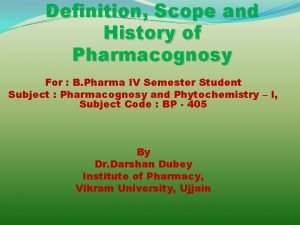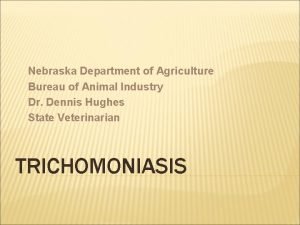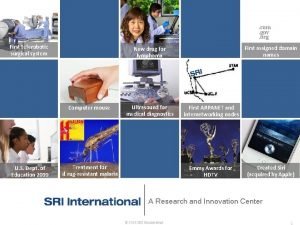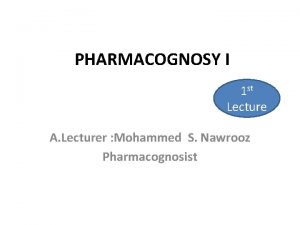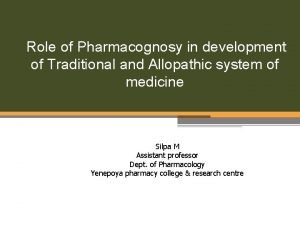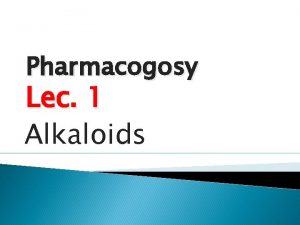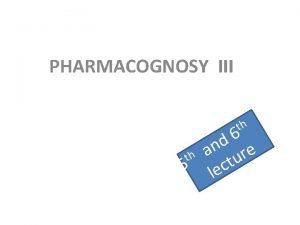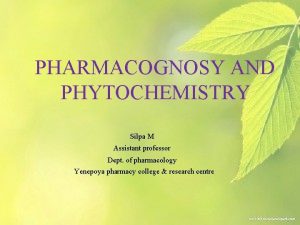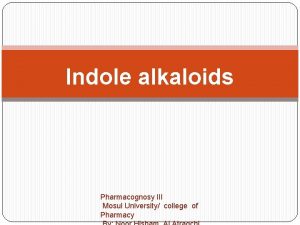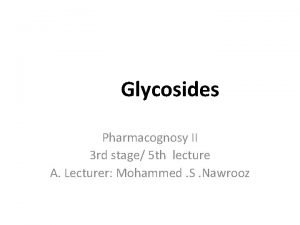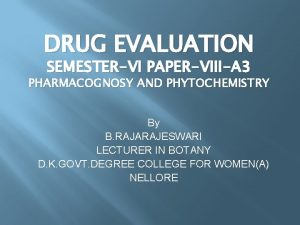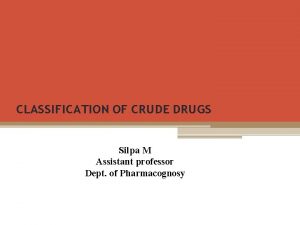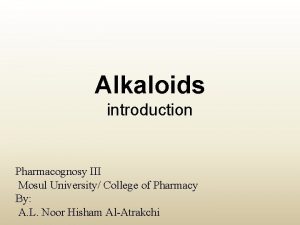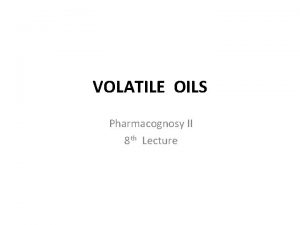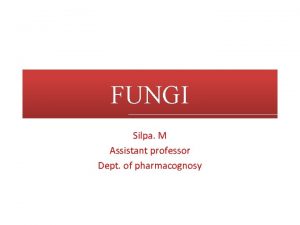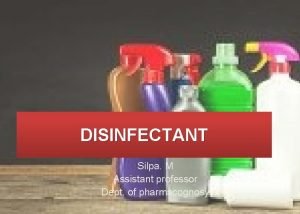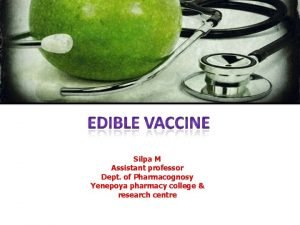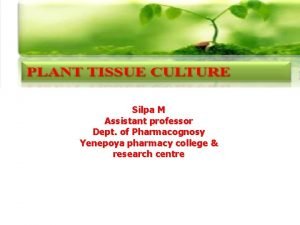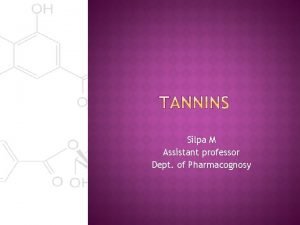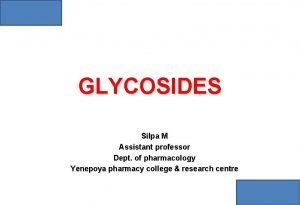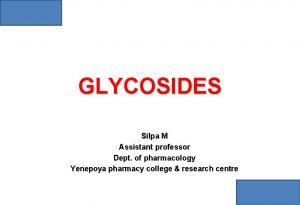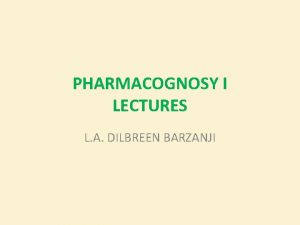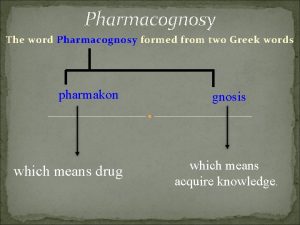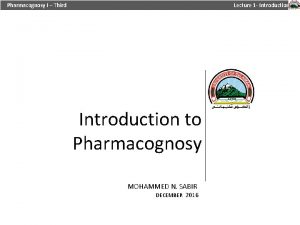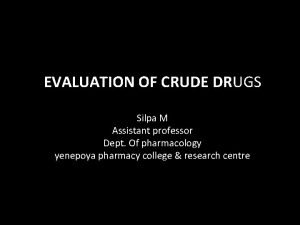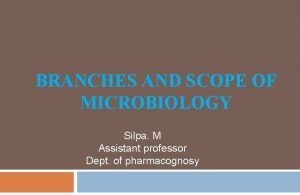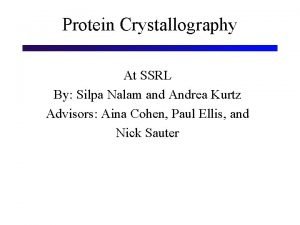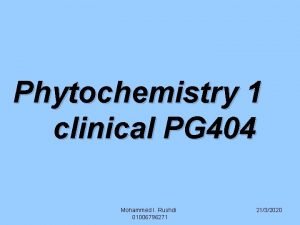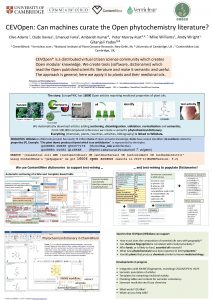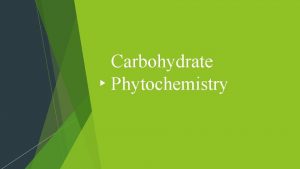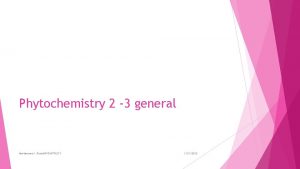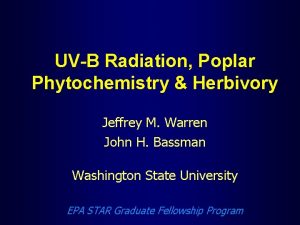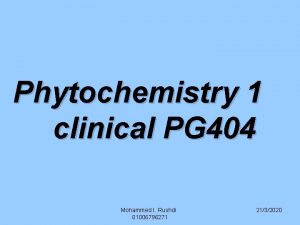PHARMACOGNOSY AND PHYTOCHEMISTRY Silpa M Assistant professor Dept



















































- Slides: 51

PHARMACOGNOSY AND PHYTOCHEMISTRY Silpa M Assistant professor Dept. of pharmacology Yenepoya pharmacy college & research centre

Pharmacognosy • The word pharmacognosy is derived from two words, pharmakon means medicine (drug) and gignosco means to acquire knowledge of something. . • pharmakon = medicine (drug) • gignosco = to acquire knowledge of something

Definition: Ø Pharmacognosy may be defined as scientific and systematic study of physical, chemical and biological characteristics of crude drugs obtained from plant, animal and mineral origins along with history, distribution, cultivation, collection and processing for market.

Historical development • In the early period, primitive man went in search of food and ate at random, plants or their parts like tubers, fruits, leaves, etc. • As no harmful effects were observed he considered them as edible materials and used them as food. • If he observed other effects by their eating they were considered inedible, and according to the actions he used them in treating symptoms or diseases. • If it caused diarrhoea it was used as purgative, if vomitting it was used as emetic and if it was found poisonous & death was caused, he used it as arrow poison.

• The knowledge was empirical and was obtained by trial and error. • He used drugs as such or as their infusions and decoctions. The results were passed on from one generation to the other, and new knowledge was added in the same way. • The history of herbal medicine is old as human civilization. The documents revealed that plants were used medicinally in China, India, Egypt and Greece long before the beginning of the Christian era.

• Pharmacognosy in Ancient Times (Before the Nineteenth Century) • The medicines originated in Egypt and India. • Medicines were recorded both in Papyrus Ebers of Egypt about 1, 500 bc and later in Ayurveda of India. In papyrus, crocus, dried ox-bile juice, castor oil, and so on were mentioned. In about 77 ad, Dioscorides, a Greek doctor, kept a record of about 600 kinds of crude drugs in his compiled book De Materia Medica, a book that had played an important role in pharmacology and botany by the fifteenth century.

• Charaka made fifty groups of ten herbs each of which, according to him, would suffice an ordinary physician's need. Similarly, Sushrutha arranged 760 herbs in 7 distinct sets based on some of their common properties. A large portion of the Indian population even today depends on the Indian System of Medicine - Ayurveda, 'An ancient science of life'. The well known treatises in Ayurveda are Charaka Samhita and Sushrutha Samhita. • Ancient Rome also promoted it development. The Historia, written by Pliny (23– 79 ad ), gave a brief account of nearly 1, 000 species of plants, most of which could be used for medicines.

• From ancient times to the middle of the nineteenth century, pharmacology had been in its traditional stage for all countries in the world. At that time, knowledge about medicines came mainly from senses and practical experiences.

Pharmacognosy in Early Modern Times (1815– 1930) • It was at the beginning of the nineteenth century that pharmacognosy came into its real being. In 1815, C. A. Seydler, a German who used the word “pharmakognosie” in his book named Analecta Pharmacognostica. • In 1806, Serturner, a German, clarified the cell to be the basic unit of plant structure, and then microscopes were used to research the internal structure of crude drugs. • In 1803, the French pharmacist, Derosne isolated narcotine from opium. In 1806, Sertuerner isolated morphine from opium and its role in alleviating pain was recognised. • Meanwhile, the qualitative and quantitative methods of chemistry were used in crude drug identification. Fluorescence analysis and chromatography were used in sequence in the latter half of the nineteenth

• All in all, the reason why pharmacognosy has become an independent subject is closely related to the development of international traffic and trade at that time. In the first half of the nineteenth century, the rapid progress in international trade gave rise to an increase in variety of medicines and resulted in enlarging scope of raw materials and medium products.

Pharmacognosy in Modern Times (1930 to the Late 1990 s) • Since the 1930 s, development of biology and chemistry enriched methods and ways of studying goods pharmacognosy. The development of the bioassay of intensity of drug action (biological potency) advanced the study of active ingredients of crude drugs and strengthened quality evaluation of them. • Chemical and physical methods, such as colorimetry, spectrophotometry, and fluorescence analysis, were all applied to identification of crude drugs gradually.

Developmental events 1. Isolation of Penicillin in in 1928 by William Fleming and large scale production in 1941. 2. Isolation of Reserpine from Rauwolfia root and confirming its hypotensive and tranquilizing properties. 3. Isolation of Vinca alkaloids, especially vincristine & viinblastine. Vincristine was found useful in the treatment of leukemia . These alkaloids also have anticancer properties, 4. Steroid hormones like progesterone were isolated by partial synthesis from diosgenin and other steroid saponins.

Period of Natural Pharmacognosy (At the End of the Nineteenth Century to the Early Twenty-First Century) • Going through the first three stages of development, pharmacognosy became an established applied discipline with advanced technology and theory. In 1970 s and 1980 s, many universities canceled the “pharmacognosy” course from their curriculum. • However, at the end of this century, with humans “returning to nature” and uprising of modern life science, pharmacognosy has presented a strong vitality and broad prospects. • Progresses in separation of the chemical composition, structure determination, and quantitative technology made 1 H NMR, 13 CNMR, DNA fingerprint identification, etc. possible to be used in the identification of crude drugs thus promoting its standardization and normalization.

Modern concept Some of the important aspects of the natural products that led to the modern development of drugs and pharmaceuticals are as follows: Isolation of phytochemicals Strong acting substances such as glycosides of digitalis, alkaloids of hyoscyamus and belladonna, ergot, rauwolfia, morphine and other alkaloids of opium were isolated and their clinical uses studied. Structure activity relationship Presence of a lactone ring is essential for the action of cardiac glycosides. Likewise anthraquinone glycosides cannot have their action without satisfying the positions at C 1, C 3, C 8, C 9

Drugs obtained by partial synthesis of natural products Oxytocic activity of methyl ergometrine is more than that of ergometrine. In ergotamine, by 9: 10 hydrogenation, oxytocic activity is suppressed and spasmolytic activity increases. The preparation of steroid hormones from diosgenin by acetolysis and oxi- dation and further preparation of cortisone by microbial reactions. Steroid hormones and their semisynthetic analogues represent a multimillion dollar industry in the United States.

Natural products as models for synthesis of new drugs • Morphine is the model of a large group of potent analgesics, cocaine for local anaesthetics, atropine for certain spasmolytics, dicoumarol for anticoagulants and salicin for salicylic acid derivatives. Without model substances from plants a large number of synthetics would have been missed. Drugs of direct therapeutic uses • Among the natural constituents, which even now cannot be replaced, are important groups of antibiotics, steroids, ergot alkaloids and certain antitumour substances. Further, drugs as digitoxin, strophanthus glycosides, morphine, atropine and several others are known since long

Biosynthetic pathways are of primary and secondary metabolites. Some of the important pathways are Ø Calvin’s cycle of photosynthesis, Ø shikimic acid pathway of aromatic compounds, Ø acetate hypothesis for anthracene glycosides , Ø isoprenoid hypothesis for terpenes , Ø steroids via acetate- mevalonic acidisopentyl pyrophosphate & squalene.

Progress from 1960 onwards During this period only a few active constituents mainly antibiotics, hormones and antitumour drugs were isolated or new possibilities for their production were found. From 6 -amino penicillanic acid, which has very little antibiotic action of its own, important broadspectrum semisynthetic penicillins like ampenicillin and amoxicillin were developed. From ergocryptine, an alkaloid of ergot, bromocryptine has been synthesized. Bromocryptine is a prolactin inhibitor and also has activity in Parkinson’s disease and in cancer. By applications of several disciplines, pharmacognosy from a descriptive subject has again developed into an integral and important disciplines of pharmaceutical sciences.

• SCOPE OF THE PHARMACOGNOSY 1. Link between ancient traditional medicinal systems and allopathic system of medicines: Ø Several traditional systems of medicine have been in practice in various countries since beginning of human civilization. Ø Ayurveda, siddha-unani, Traditional Chinese medicine, Alternaive and complementary medicinal system of western countries are the few examples.

Ø Pharmacognosy is giving a wide knowledge about these traditional medicinal systems, whereas it also describes the chemical constituents of individual drug and its biological activity. Ø Many drugs which are used in modern medicinal system have been isolated from natural sources. Ø Thus Pharmacognosy has made vital link between traditional knowledge of medicinal systems with modern allopathic system of medicine.

2. Application of botany and zoology • Modern Pharmacognosy has counted in detailed about natural drugs from plant and animal sources, where it also described the cellular structure of individual drugs. Example; I)Morphological study of organized or unorganized crude drugs. Like color, shape, odour, size, taste. II) Microscopical study gives a detailed account on cellular structure of crude drugs.

a. Transverse section of leaves, stems, seeds, flower buds. b. Microscopical study of powder drugs. Taxonomical classification and binomical nomenclature of plants and animals of the source of crude drugs are also included in Pharmacognosy. Thus it also made a link with Botany and Zoology.

3. Application of Chemistry/ Medicinal chemistry • Crude drugs contain various chemical moieties which are responsible for their biological activities. • These chemical moieties can be explained by the knowledge of organic and inorganic chemistry. • IUPAC (International Union of Pure and Applied Chemistry) nomenclature system is also applicable for individual chemical constituents of crude drugs. • Hence, application of chemistry in Pharmacognosy discipline is also prominent.

• As chemical constituents posses medicinal activities which can be studied by ‘structural activity relationship’ (SAR) in medicinal chemistry discipline. • Medicinal chemistry also able to describe the chemical nature and properties of individual chemical constituents which helps in classification of different chemical compounds in various classes, like, Carbohydrate, Protein, Lipids, Glycosides, Alkaloids, Volatile oil, Steroids, Triterpinoids and etc. • So Pharmacognosy also has a relation with medicinal chemistry discipline.

4) Application of Pharmacology • Pharmacology helps to describe about medicinal/biological activities of crude drugs and their mechanism of action. It also helps to classify the drugs according to pharmacological activity. For example: Ø Cardiotonic – Digitalis, Strophanthus Ø Anticancer – Vinca Ø Antimalarial – Cinchona Ø Antidiabetic – Gymnema, Pterocarpus

5) Application of Biochemistry • Biochemical or biosynthetic pathways have an important role in production of chemical compounds in nature. Example: Photosynthesis, Kreb’s cycle, Mavelonic acid pathway, • Shikimic acid pathway. The study of these pathways gives a continuous supply of crude drugs. • The cultivation also helps to conserve the endangered species of plants.

7) Application of Biotechnology • Biotechnology helps to develop various method of genetic breeding for cultivating disease resistant plants with high yield of active constituents. For example: § Selective breeding of Cinchona ledgeriana showed increased alkaloidal yield from 5 to 15%. § The isolation of DNA from different plant species helps to develop molecular marker for individual plants. § Plant tissue culture, animal tissue culture, cell culture techniques play an important role for

8) Industrial approach • In recent days globally pharmaceutical industries have been turned towards natural products. • This increases the demand of natural products as a source for drugs which also helps to develop new techniques for extracting, isolating chemical compounds from natural sources.

9) Intellectual Property Rights • Intellectual property rights are applicable for patenting natural drugs which can save its originality of discovery and also helps for trading.

10) Trading of Natural Products • High demand of natural products helps to earn maximum foreign exchange by many countries. • Indian earns a maximum foreign exchange by exporting the plant drugs. According to statistics report India exported medicinal plants worth Rs. 800 crore in 2006. • From the itemized export, it could be noted that opium is the biggest earner of foreign exchange and senna leaves and pods has been another major item of export.

q. Some of the examples of drug with export potential are listed below: i) India exported cardamom oil and cardamom oleoresin of Rs. 22 lakhs and Rs. 135 lakhs respectively 1996 -97. ii) Isapgol husk and seeds – during 2004 -05 was US$1. 78 million respectively. iii) India exported opium of US$ 18. 72 million in 2004 -05. iv) Senna leaves and pods- US$ 6. 10 million in 2004 -05.

Sources of drugs of natural origin (DONO) Plants, animals, minerals, marines and plant tissue culture Plants Plant source is the oldest source of drugs. Most of the drugs in ancient times were derived from plants. Almost all parts of the plants are used i. e. leaves, stem, bark, fruits and roots etc Leaves: The leaves of are the source of Digitoxin and Digoxin, which Digitalis purpurea are cardiac glycosides. Leaves of Eucalyptus give oil of Eucalyptus, which is important component of cough syrup. Tobacco leaves give nicotine. Atropa belladonna gives atropine.

Flowers: Clove gives eugenol Vinca rosea gives vincristine and vinblastine Rose gives rose water used as tonic. Fruits Senna pod gives anthracine, which is a purgative (used in constipation) Calabar beans give physostigmine, which is cholinomimetic agent. Seeds: Seeds of Nux Vomica give strychnine, which is a CNS stimulant. Castor seeds give castor oil. Calabar beans give Physostigmine, which is a cholinomimetic drug.

Roots: Ipecacuanha root gives Emetine, used to induce vomiting as in accidental poisoning. It also has amoebicidal properties Rauwolfia serpentina gives reserpine, a hypotensive agent. Reserpine was used for hypertension treatment. Bark: Cinchona bark gives quinine and quinidine, which are antimalarial drugs. Quinidine also has antiarrythmic properties. Stem: Kalmegh Hepatoprotective

Animal Sources: Pancreas is a source of Insulin, used in treatment of Diabetes. Sheep thyroid is a source of thyroxin, used in hypertension. Cod liver is used as a source of vitamin A and D. Blood of animals is used in preparation of vaccines. Cochineal (dried full grown female insects) consist of carminic acid used as colouring agent for foods, drugs and for cosmetic products

Marines • The greater part of the earth surface is covered by seas and ocean, which contains about 5, 000 species of marine organisms. • Many of these compounds have shown pronounced biological activity. • In the western medicine agar, alginic acid, carrageenan, protamine sulphate, spermaceti & cod and halibut liver oils are the established marine medicinal products. • Macroalgae or seaweeds have been used as crude drugs in the treatment of iodine deficiency states such as goitre, etc. Some seaweed have also been utilized as sources of additional vitamins and in the treatment of anaemia during pregnancy.

• During the last 30– 40 years numerous novel compounds have been isolated from marine organisms having biological activities such as antibacterial, antiviral, antitumour, antiparasitic, anticoagulants, antimicrobial, antiinflammatory and cardiovascular active products. • Ara-A Semisynthetic - antiviral agent • Bryostatin - Anticancer agents • Octopamine - Cardiovascular agent • Bio-indol derivatives - Antiinflammatory

Tissue culture • Tissue culture is in vitro cultivation of plant cell or tissue under aseptic and controlled environmental conditions, in liquid or on semisolid well-defined nutrient medium for the production of primary and secondary metabolities or to regerate plant. • This technique affords alternative solution to problems arising due to current rate of extinction and declimation of flora and ecosystem. • The whole process requires a well –equipped culture laboratory and nutrient medium.

• This process involves various steps, viz. preparation of nutrient medium containing inorganic and organic salts, supplemented with vitamines, plant growth hormoness and amino acides as well as sterilization of explant (source of plant tissue), glassware and other accessories inoculation and incubation. Ø Applications § Production of Phytopharmaceutical § Biochemical Conversions § Clonal Propagation (Micro-propagaion) § Production of immobilized Plant cell

Crude drugs The term ‘crude drug’ means the natural product that has not been advanced in value or improved in condition by any other process or treatment except collection and drying. • Crude drugs are further grouped as organised (cellular) and unorganised (acellular).

Organized crude drugs: organized drugs comprise those crude drugs material which represent a part of the plants and are, therefore, made up of cells. 1. They are organs or direct parts of plants or animals which have definite cellular structure. 2. They are solid in nature 3. They are identified by Morphological and Microscopical/ Anatomical (T. S) characters.

Example: Leaf: - Senna, Digitalis, Datura Stem: - Ephedra Bark: - Cinchona, Quassia, Cassia Flower: - Pyrethrum Flower bud: - Clove Fruit: - Fennel, Coriander Seed: Nux-vomica, Linseed Root: - Liquorice, Rauwolfia Rhizome: - Ginger, Podophyllum

Unorganised crude drugs: • Unorganized crude drugs are a diverse group of solid and liquid materials which do not consist of parts of plants and are obtained from natural sources by a variety of extraction procedures. 1. They are derived from parts of plant or animal by some process of extraction and they don’t have any definite cellular structures. 2. They are solid, semisolid or liquids in nature. 3. They are identified by organoleptic property (using sense organ) and chemical tests. Examples: - Aloe, agar, colophony, opium, castor oil, beeswax, pepsin, etc.

Difference between Organised and Unorganised drugs Organised crude drugs Unorganised crude drugs 1. They are ‘organs’ of plants or animals and 1. They are derived from parts of the plant or are made up of cells or definite structure. animal by some process of extraction and Eg: flowers, seeds, fruits, insects, etc. followed by purification, if necessary and they don’t have any definite cellular structure. Eg: juices, extracts, resins, etc. 2. They are solid in nature. 2. They are solid, semisolid or liquid in nature. Eg: oils, gums and balsams. 3. Botanical or zoological terminology can be 3. Such terminology is inadequate to describe used to describe these drugs. them, but one has to look for their physical characters, such as the solubility in various solvents, density, optical rotation, refractive index, etc. whichever is applicable. 4. Morphological and Microscopical characters are the important criteria for the identification of organized drugs. Examples: Digitalis, cinchona, clove, fennel, ephedra, etc. 4. Organoleptic and Chemical testes are used for their identification. Examples: Aloe, agar, colophony, opium, castor oil, bees-wax, pepsin, etc.

Unorganized drugs • Latex o Latex is a product present in special tissue of plant it is white, aqueous, suspension, the suspended particles are protein, sugar, minerals, alkaloid, resin, or starch. o Under microscope- small particles of oil globules. Eg: opium, papain, .

Dried juices • The juice obtained from fleshy leaves (aloes) or from the stems of the trees (kino) Dried extracts • Pharmacognostic origin drugs are obtained by treating the part of plant with water or distillation followed by concentration. • Pharmaceutical origin drugs are obtained by alcoholic or hydro alcoholic solutions and adjusting the product to standard strength. e. g. Agar, black catechu, gelatin

Gums • Amorphorus substances, pathological products produced when the plant under unfavorable conditions or injured. Mucilage • Thick, gluey substance produced by most plants and some microorganisms. Gums Mucilage Gums are produced by plant when it Mucilage is the normal products of injured, diseased or by aprocess plant growth. “Gummosis” Gum is produced outside the plant cell. Mucillage is produced inside the cell. Gums are soluble in water to form Mucilage are not soluble in water, they adhesive solution. from slimy solution with water. Gums are made up of sugar, salts of Mucilage is made up of ester & uronic acid e. g. Gum acacia, gum Sulphuric acid. E. g. Mucilage is present Tragacanth. in Agar, Senna, Isapgol.

Oleoresins and Oleo-gum-resins Oleoresins Homogenous mixture of volatile oil & resin is called as oleoresin e. g. Oleoresin of Ginger Oleo-gum-Resin Homogenous mixture of volatile oil, gum & resin. e, . g. Myrrh, Asafoetida

Official drugs • Any substance or drug (crude or prepared), which is included in the issue of the pharmacopoeia of a country and is officially used for therapeutic purposes, is called an official drug. • Whole plant Catharanthus and their active constituents (Vincristin and vinblastin) these are used in treating cancer diseases. • Latex of fruit of poppy plants (Papaver sp. ) and its acive constituents as (Morphine) used as narcotic. • Caffine from the seeds of Coffee plants & thiamine from leaves of tea plants are used as stimulants.

Unofficial drug • A drug, which has once been recognized a drug in the pharmacopeia, but not included in the issue of the pharmacopeia or any official drug literature, is designated as an unofficial drug.

THANK YOU
 Definition and history of pharmacognosy
Definition and history of pharmacognosy Parent portal amnuay silpa
Parent portal amnuay silpa Amnuay silpa tuition fee
Amnuay silpa tuition fee Promotion from associate professor to professor
Promotion from associate professor to professor Cuhk salary scale 2020
Cuhk salary scale 2020 Ms department of finance and administration
Ms department of finance and administration Florida dept of agriculture and consumer services
Florida dept of agriculture and consumer services Florida dept of agriculture and consumer services
Florida dept of agriculture and consumer services Florida department of agriculture and consumer services
Florida department of agriculture and consumer services Dept nmr spectroscopy
Dept nmr spectroscopy Organizational structure of finance department
Organizational structure of finance department Inspectors in worcester
Inspectors in worcester Dept. name of organization (of affiliation)
Dept. name of organization (of affiliation) Mn dept of education
Mn dept of education Dept. name of organization
Dept. name of organization Employment first ohio
Employment first ohio Affiliation poster presentation
Affiliation poster presentation Vaginal dept
Vaginal dept Gome dept
Gome dept Gome dept
Gome dept Horizontal
Horizontal Gome dept
Gome dept Hoe dept
Hoe dept Battalion chief interview questions
Battalion chief interview questions Oviposition
Oviposition Dept of education
Dept of education Dept a
Dept a Central islip fire dept
Central islip fire dept Rowan county dss
Rowan county dss Dept of education
Dept of education Dept c13 nmr
Dept c13 nmr Pt dept logistik
Pt dept logistik Nys department of homeland security
Nys department of homeland security La dept of revenue
La dept of revenue La geaux biz
La geaux biz Oxford dept of continuing education
Oxford dept of continuing education Nebraska dept of agriculture
Nebraska dept of agriculture Ee dept iitb
Ee dept iitb Dept ind onegov
Dept ind onegov Albany county dss
Albany county dss History and scope of pharmacognosy
History and scope of pharmacognosy What are the duties of assistant scorer?
What are the duties of assistant scorer? Madar, kabab chini, tagar are the examples
Madar, kabab chini, tagar are the examples Alkaloids definition
Alkaloids definition Pharmacognosy alkaloids
Pharmacognosy alkaloids Organised and unorganised drugs difference
Organised and unorganised drugs difference Uses of alkaloids in pharmacognosy
Uses of alkaloids in pharmacognosy Glycosides in pharmacognosy
Glycosides in pharmacognosy Vein islet number example
Vein islet number example Advantages of chemotaxonomical classification
Advantages of chemotaxonomical classification Uses of alkaloids in pharmacognosy
Uses of alkaloids in pharmacognosy Ketone volatile oils
Ketone volatile oils
